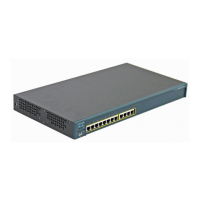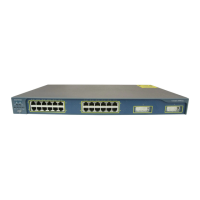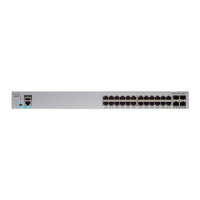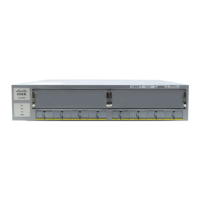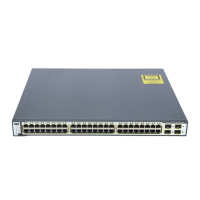7-21
Catalyst 4500 Series, Catalyst 2948G, Catalyst 2948G-GE-TX, and Catalyst 2980G Switches Software Configuration Guide—Release 8.2GLX
78-15908-01
Chapter 7 Configuring Spanning Tree
Understanding How MST Works
Message Age and Hop Count
IST and MST instances do not use the Message Age and Maximum Age timer settings in the BPDU. IST
and MST use a separate hop count mechanism that is very similar to the IP TTL mechanism. You can
configure each MST bridge with a maximum hop count. The root bridge of the instance sends a BPDU
(or M-record) with the remaining hop count that is equal to the maximum hop count. When a bridge
receives a BPDU (or M-record), it decrements the received remaining hop count by one. The bridge
discards the BPDU (M-record) and ages out the information held for the port if the count reaches zero
after decrementing. The nonroot bridges propagate the decremented count as the remaining hop count in
the BPDUs (M-records) they generate.
The Message Age and Maximum Age timer settings in the RST portion of the BPDU remain the same
throughout the region, and the same values are propagated by the region’s designated ports at the
boundary.
MST-to-PVST+ Interoperability
These guidelines apply in a topology where you configure MST switches (all in the same region) to
interact with PVST+ switches that have VLANs 1–100 set up to span throughout the network:
• Configure the root for all VLANs inside the MST region. The ports that belong to the MST switch
at the boundary simulate PVST+ and send PVST+ BPDUs for all the VLANs. This example shows
the ports simulating PVST:
Console> (enable) show spantree mst 3
Spanning tree mode MST
Instance 3
VLANs Mapped: 31-40
Designated Root 00-10-7b-bb-2f-00
Designated Root Priority 8195 (root priority:8192, sys ID ext:3)
Designated Root Cost 0 Remaining Hops 20
Designated Root Port 1/0
Bridge ID MAC ADDR 00-10-7b-bb-2f-00
Bridge ID Priority 8195 (bridge priority:8192, sys ID ext:3)
Port State Role Cost Prio Type
------------------------ ------------- ---- -------- ------------------------
6/1 forwarding BDRY 10000 30 P2P,
Boundary(PVST)
6/2 blocking BDRY 20000 32 P2P,
Boundary(PVST)
If you enable loop guard on the PVST+ switches, the ports might change to a loop-inconsistent state
when the MST switches change their configuration. To correct the loop-inconsistent state, you must
disable and reenable loop guard on that PVST+ switch.
• Do not locate the root for some or all of the VLANs inside the PVST+ side of the MST switch,
because when the MST switch at the boundary receives PVST+ BPDUs for all or some of the
VLANs on its designated ports, root guard sets the port to the blocking state. Do not designate
switches with a slower CPU running PVST+ as a switch running MST.

